Your traditional pies can actually bake better under natural sunlight due to the unique way solar heat distributes through the crust and filling. You'll get more even cooking as sunlight heats surfaces uniformly, creating a perfect balance of tenderness and crispiness. The natural convection in solar ovens mimics professional steam-injected ovens, helping you achieve that coveted golden-brown crust. Plus, the slower cooking process at temperatures between 160-200°F enhances flavors and textures in ways conventional ovens can't match. There's much more to discover about this sustainable, flavor-boosting baking method that's revolutionizing traditional pie making.
The Power of Solar Heat
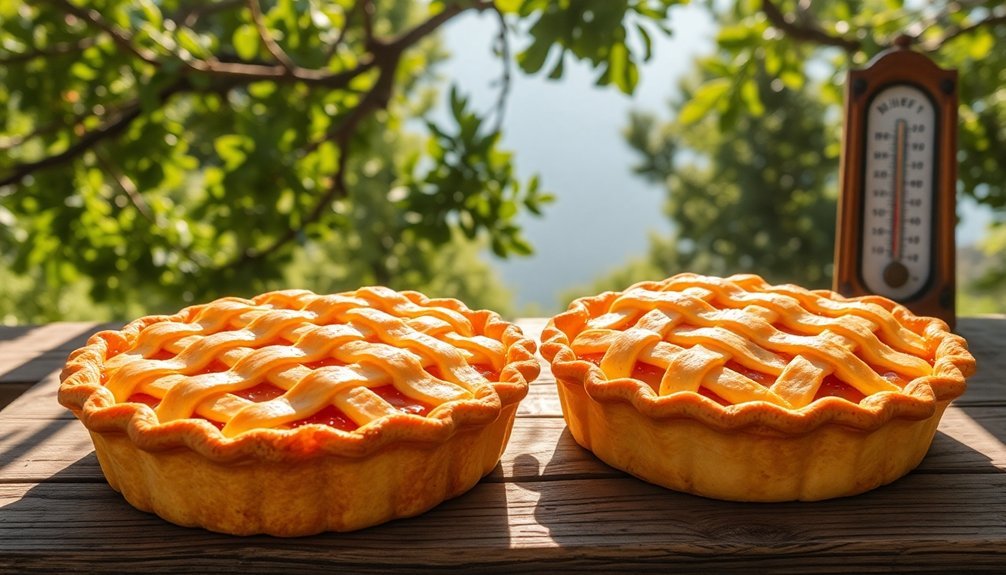
While traditional ovens have long dominated pie baking, solar heat offers a revolutionary approach to creating perfect pastries.
You'll discover that harnessing sunlight not only reduces your energy costs but also promotes environmental sustainability through zero-emission cooking.
Solar heat provides a gentler, more controlled baking environment that's ideal for achieving the perfect pie.
You won't need to worry about burnt crusts or uneven baking, as the consistent temperature distribution guarantees uniform results. Your pastries will develop enhanced texture and flavor through the slow cooking process.
With temperatures reaching up to 150°C, you'll get thoroughly cooked pies while preserving their nutritional value.
What's more, you're not limited to just pies – you can experiment with various recipes from tarts to gratins.
Though you'll need to adjust the oven's position periodically, the energy independence and cost savings make solar baking a worthwhile investment.
Natural Light and Crust Development
You'll notice that natural light plays a surprising role in achieving the perfect golden-brown crust through UV exposure, which works alongside the Maillard reaction.
The natural heat distribution patterns from sunlight can complement your oven's thermal dynamics, particularly when using lightweight, conductive pie plates. This process is enhanced through proper gluten development when the dough is handled carefully during preparation.
Your crust's texture benefits most when you position the pie to receive consistent natural light while baking, enhancing both its structural integrity and visual appeal.
Golden Brown UV Effect
Despite popular beliefs about natural light's impact on pie crusts, the golden-brown color we associate with perfectly baked pies isn't directly influenced by UV exposure before baking. While UV light can affect yeast on the dough's surface, it doesn't penetrate deeply enough to greatly impact your pie's development. Traditional methods like using parabolic dish reflectors can enhance the baking process in sunny conditions.
| Factor | Impact on Crust | Key Influence |
|---|---|---|
| UV Light | Minimal | Surface Only |
| Temperature | High | Throughout Dough |
| Maillard Reaction | High | During Baking |
You'll find that your pie's perfect golden-brown finish comes from the Maillard reaction during baking, not from pre-baking light exposure. What really matters is maintaining proper temperature control and ensuring even heat distribution. While natural sunlight might warm your dough, it's the baking temperature and conditions that truly determine your crust's final color and texture.
Heat Distribution Patterns
Three key mechanisms govern heat distribution in pie baking: radiation, convection, and surface conduction.
When you're baking under natural sunlight, you'll experience superior heat distribution compared to traditional ovens. The sun's direct radiation provides more intense and even heating, following the Stefan-Boltzmann law more efficiently than oven walls alone.
You'll notice that sunlight heats surfaces more uniformly, which improves heat conduction through your baking surface to the pie. The thermal properties of your baking surface, including its specific heat capacity, will significantly impact heat transfer to the crust.
While conventional ovens rely on limited natural convection, sunlight's heating of surrounding surfaces creates more effective air movement patterns.
The difference is particularly noticeable in crust development – sunlight's direct radiation can help you achieve more even browning without the need for artificial convection.
This natural heat distribution pattern closely mimics what you'd get in professional steam-injected ovens.
Crust Texture Enhancement
Natural light's impact on crust texture development relies on four essential components: ingredient temperature control, moisture retention, gluten formation, and surface browning patterns.
When baking under natural sunlight, you'll want to maintain cold ingredients, especially your butter and liquids, as they're vital for achieving flaky layers. The gradual warming from sunlight helps your dough maintain its structure while allowing the butter to create steam pockets effectively.
You can enhance this process by combining butter with shortening, which provides both flavor and stability.
To optimize your crust's texture in natural light, you'll need to chill your dough properly and consider using vodka or vinegar to control gluten development.
Remember to rest your dough adequately, allowing the gluten to relax before rolling it out.
Solar Temperature Control Basics

You'll need to understand natural heat patterns in your solar oven, where direct and reflected sunlight creates hot spots that require careful placement of your pie for even baking.
To achieve ideal baking temperatures between 160-200°F, you must constantly monitor sunlight intensity and adjust your reflective surfaces throughout the day.
Your success depends on maintaining steady temperatures by using proper insulation methods, such as creating an effective greenhouse effect with clear plastic wrap and maximizing heat absorption with dark-colored surfaces.
Natural Heat Distribution Patterns
Understanding solar heat distribution begins with the fundamental process of capturing and concentrating sunlight. You'll find that large silver mirrors and reflective surfaces work together to magnify the sun's rays, focusing them into a concentrated area where temperatures can reach up to 325°F. When you're baking pies, this natural heat distribution creates an ideal environment through the strategic placement of heat-retaining materials.
| Heat Zone | Temperature Range | Baking Effect |
|---|---|---|
| Upper | 250-325°F | Top browning |
| Middle | 200-250°F | Even cooking |
| Center | 175-200°F | Core heating |
| Bottom | 160-175°F | Crust crisping |
The heat distribution relies on proper mirror alignment and effective insulation. You'll notice that the black paper at the oven's bottom acts as a heat sink, while the plastic "window" traps warmth like a greenhouse, ensuring your pie bakes consistently.
Sunlight Intensity Monitoring
Building on the principles of heat distribution, monitoring sunlight intensity forms the cornerstone of successful solar baking.
You'll need to track your oven's temperature, which can reach 160-200°F in simple setups and over 350°F in advanced models. For ideal results, you'll want to position your oven where it receives direct sunlight throughout the cooking process.
When baking pies, you'll discover that temperature control isn't as precise as conventional ovens. You must adjust the oven's position regularly to maintain consistent heat.
Pre-heating your solar oven will reduce overall cooking time, especially for frozen pies that typically need 3.5 to 4.5 hours.
Remember that effective insulation using materials like aluminum foil and black paper will help maintain steady temperatures even when sunlight varies.
Temperature Retention Methods
While solar ovens present unique temperature control challenges, several proven methods help maintain consistent heat for successful pie baking.
You'll need to monitor and maintain temperatures between 200-300°C (390-570°F) for best results. Just like traditional ovens, proper heat retention guarantees even cooking and perfect crust formation.
Follow these essential temperature retention methods:
- Start with high heat (around 400°F) to achieve the initial golden-brown crust, then reduce to prevent burning.
- Use dark-colored baking dishes that absorb and retain heat more effectively.
- Monitor moisture levels carefully, as solar ovens typically create lower humidity environments.
- Calculate ideal ingredient temperatures beforehand, considering room temperature and desired dough consistency.
Remember that proper insulation and consistent temperature monitoring are vital for achieving that perfect balance of tenderness and crispiness in your solar-baked pies.
Seasonal Ingredients Matter
When creating traditional pies throughout the year, choosing seasonal ingredients can dramatically enhance both flavor and quality.
You'll find citrus fruits perfect for winter pies, while spring brings strawberries and rhubarb for vibrant combinations. Summer's bounty offers a mix of berries and stone fruits, ideal for creating naturally sweet, flavorful fillings.
You don't need to rely on preservatives when you're using fresh, seasonal ingredients. By slow-roasting fruits like pumpkins in fall or pre-cooking juicy summer berries, you'll achieve superior texture and taste.
Combining seasonal fruits, such as blueberries with peaches in May or apples with raspberries in September, creates balanced flavors that honor traditional pie-making methods. Each season brings its unique offerings, allowing you to craft pies that reflect nature's rhythm.
Preparing Your Solar Workspace
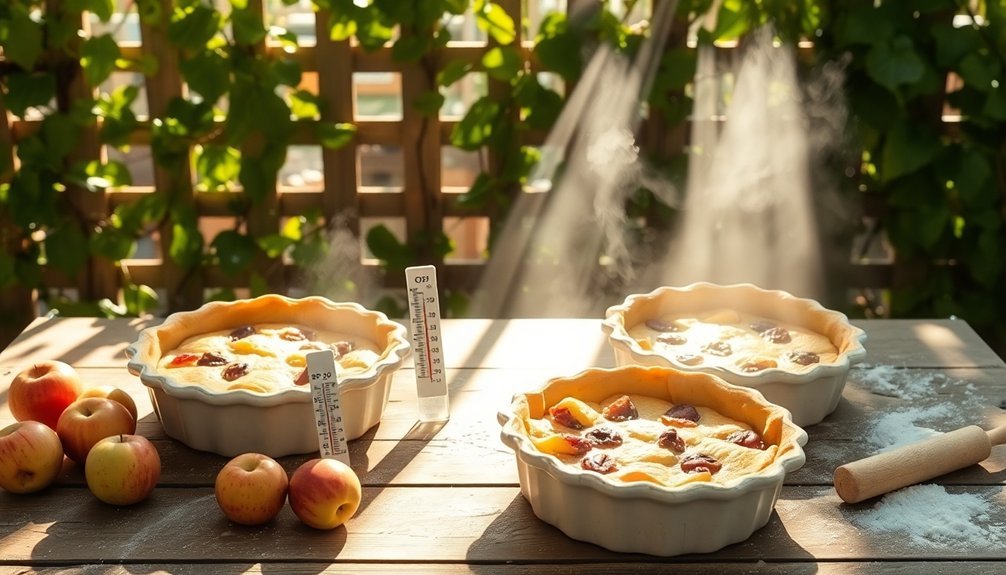
A successful solar oven workshop starts with the right workspace preparation.
You'll need to choose a clear, organized area that receives ample sunlight, particularly during peak hours between 11 am and 3 pm.
Make sure you've gathered all essential materials before beginning, including cardboard boxes, aluminum foil, and insulation materials.
For ideal results, follow these key setup steps:
- Position your workspace near a full-sun window or choose a protected outdoor location.
- Set up tables and chairs to accommodate all participants comfortably.
- Organize materials in easily accessible stations for efficient workflow.
- Clear the area of any obstacles that might cast shadows on your solar ovens.
Remember to adjust your oven's reflector throughout the cooking process and maintain safety protocols for the best pie-baking results.
Essential Solar Baking Equipment
To successfully bake pies using solar energy, you'll need specialized equipment designed for ideal heat collection and retention. Top-rated ovens like the GoSun Sport and Solavore Sport offer peak temperature ranges for pie baking, reaching up to 550°F and 275°F respectively.
| Equipment Feature | Baking Benefit |
|---|---|
| Reflective Panels | Concentrates sunlight for consistent heating |
| Vacuum Tubes | Maintains steady baking temperatures |
| Insulation | Prevents heat loss during cooking |
| Thermometers | Monitors precise baking temperatures |
| Adjustable Mounts | Guarantees peak sun exposure |
You'll find models like the Sunflair Deluxe and Haines Solar Cooker particularly suitable for pie baking, as they include essential features like temperature monitoring and durable construction. Look for ovens with multi-functional capabilities and weather-resistant materials to guarantee your pies bake perfectly every time.
Perfect Timing for Solar Pies
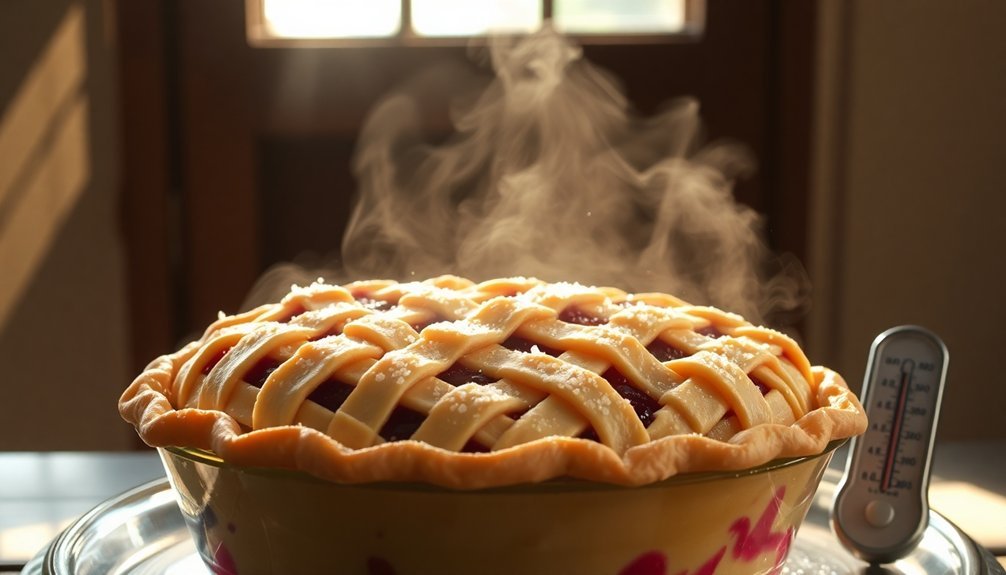
You'll get the best results from your solar pie baking between 10 AM and 2 PM when the sun's intensity peaks and temperatures climb toward 82°F.
Your baking schedule should shift with the seasons, starting earlier in summer months and later in winter to maximize direct sunlight exposure.
When clouds threaten to interrupt your baking, you'll need to add extra time to account for temperature fluctuations, potentially extending a large frozen pie's cooking time beyond the typical 3.5 to 4.5 hours.
Solar Baking Peak Hours
When planning to bake pies in a solar oven, timing your cooking around peak sunlight hours becomes critical for success.
You'll want to start early in the day when the sun is strong and climbing to its highest point. Position your oven to catch direct sunlight, and remember to adjust its orientation every hour or two for consistent heating.
- Start preheating your solar oven when ambient temperatures reach around 82°F
- Expect cooking times to be 1.5 times longer than traditional oven baking
- Monitor internal temperatures until they reach 300-325°F
- Plan for about 4.5 hours of cooking time for large pies
Keep in mind that factors like pie size, frozen state, and sun intensity will affect your baking time.
Use a laser infrared thermometer to check if your pie's fully cooked.
Seasonal Time Adjustments
Since the sun's position changes dramatically throughout the year, successful solar pie baking requires careful seasonal adjustments to your timing and technique.
You'll need to adjust your solar oven more frequently during winter and spring when the sun sits lower on the horizon, while summer allows for less frequent repositioning.
Plan your pie baking schedule according to seasonal variations. Winter and spring call for longer cooking times due to less intense sunlight, so start earlier in the day.
In summer, you can begin later since the intense sunlight shortens cooking times. Dark-colored pie pans will help absorb heat efficiently year-round.
Monitor shadows to gauge when you need to reposition your oven, and don't forget to preheat it before adding your pie, especially during colder months when maintaining ideal temperature is essential.
Weather Impact Scheduling
Successful solar pie baking depends heavily on weather conditions and careful timing throughout the day.
You'll need to monitor humidity levels and air temperature to achieve the perfect crust and filling consistency. When humidity rises, your pie's texture can become compromised, while warmer temperatures affect how quickly your fats melt during preparation.
To master weather-based pie scheduling:
- Start baking early on humid days to combat moisture absorption in your dry ingredients.
- Choose cooler morning hours when butter and fats are naturally more stable.
- Adjust your baking time and temperature based on the day's humidity forecast.
- Shield your workspace from direct sunlight to maintain consistent dough temperature.
Remember to store your ingredients properly and consider using chilled components when the weather's particularly warm to guarantee ideal results.
Environmental Impact on Results
As climate change continues to reshape our environment, traditional pie baking faces unprecedented challenges that affect every aspect of the process. You'll notice changes in ingredient quality as weather patterns impact crops, altering the flavor profiles of your pie fillings and crusts. Rising temperatures affect fermentation times, making it harder to achieve that perfect flaky texture you're aiming for.
| Impact Area | Challenge | Solution |
|---|---|---|
| Ingredients | Lower nutrient content | Source locally |
| Baking Time | Inconsistent rise | Adjust recipes |
| Flavor | Altered compounds | Cool ingredients |
When you're working with climate-stressed ingredients, you'll need to make adjustments to your traditional recipes. Consider controlling your kitchen's temperature and humidity levels to maintain consistency in your results. You can also support sustainability by choosing locally sourced ingredients and reducing food waste.
Crust Techniques for Solar Success
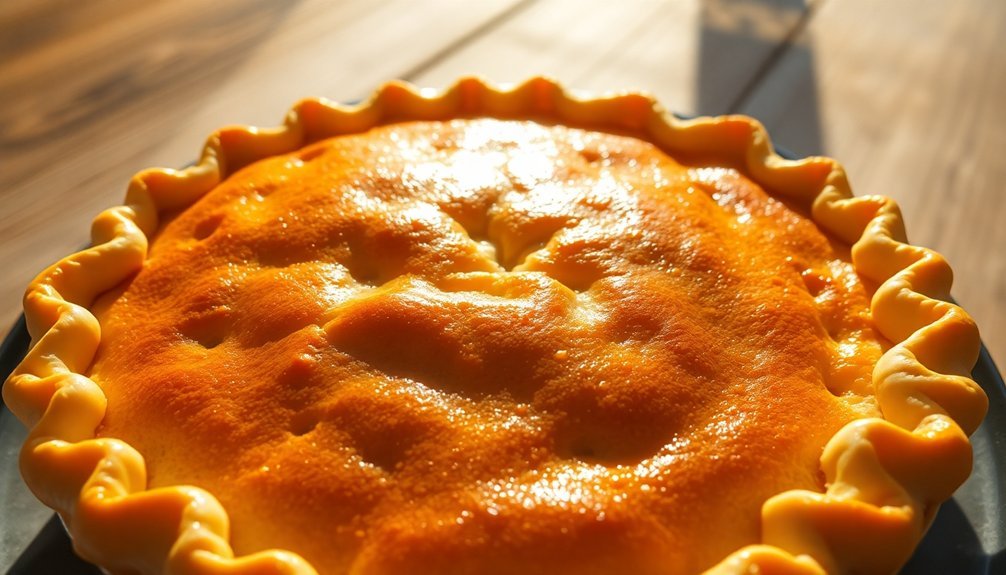
Building on our climate awareness, mastering solar pie baking brings sustainable practices directly into your kitchen. When preparing your crust for solar baking, you'll need to adapt traditional techniques to work with nature's oven.
- Roll your crust with at least 1" overhang and press it firmly against your dark solar-recommended dish without stretching – this prevents shrinking and maximizes heat absorption.
- Chill your dough thoroughly before working with it, as solar ovens can heat unevenly and you'll want structural integrity.
- Use aluminum pie plates as weights during blind baking, which conduct heat better than traditional ceramic weights.
- Place your pie on a flat cookie sheet for stability, as you'll need to monitor and adjust its position throughout the baking process.
Remember to preheat your solar oven and be patient with the process.
Filling Modifications for Sunlight Baking
When preparing fillings for solar-powered baking, you'll need to modify traditional recipes to accommodate the unique characteristics of sunlight cooking. Pre-cook your fruit fillings to reduce overall baking time and guarantee even cooking.
You'll want to add extra thickening agents to fresh fruit mixtures to prevent excess moisture from making your crust soggy.
For custard-based pies, blind baking is essential since sunlight cooking can be less predictable. You'll achieve better results by pricking your crust and using weights during pre-baking.
When working with nuts or chocolate fillings, protect them from direct exposure to prevent burning. Consider placing foil around the edges if they're browning too quickly.
Mix sweet fillings with complementary ingredients to create complex flavors that shine under solar heating.
Remember to cool your pre-baked shell completely before adding any filling.
Traditional Methods Meet Solar Innovation

The marriage of traditional pie-making techniques with solar baking opens up exciting possibilities for eco-conscious bakers.
You'll find that many conventional pie-making principles adapt well to solar ovens, though you'll need to make some adjustments for ideal results.
When combining traditional methods with solar innovation, follow these key steps:
- Prepare your dough using cold ingredients and minimal handling, just as you'd for conventional baking.
- Preheat your solar oven with a dark baking sheet to guarantee proper bottom crust development.
- Use reflectors to maintain consistent temperatures, mimicking the traditional high-to-low heat method.
- Monitor your pie's progress closely, as solar baking times may vary based on sunlight intensity.
Remember to maintain proper insulation in your solar oven to achieve the golden-brown crust that's characteristic of traditionally baked pies.
Frequently Asked Questions
Can Solar-Baked Pies Be Made on Cloudy or Partially Overcast Days?
Yes, you can bake pies on cloudy days using a solar oven, but you'll need to extend cooking times considerably. You'll want to monitor temperatures closely and be prepared for slower baking than on sunny days.
How Does Altitude Affect Solar Pie Baking Compared to Conventional Ovens?
You'll find solar pie baking more challenging at high altitudes due to thinner air and varied temperatures, while conventional ovens let you precisely control heat and adjust recipes for consistent results in any elevation.
Are Certain Pie Dishes Better Suited for Solar Baking?
You'll get the best results using dark-colored metal or glass pie dishes that absorb heat well. Avoid shiny aluminum pans, and opt for dishes with tight-fitting lids to maintain consistent temperatures during solar baking.
Do Certain Spices React Differently When Baking With Natural Sunlight?
You'll notice that spices react differently to sunlight while baking. Dark-colored spices like paprika and turmeric degrade faster, while hardier spices like peppercorns and cinnamon maintain their flavor better during sun exposure.
Can Solar Ovens Maintain Consistent Temperatures During Winter Months for Pie-Making?
You'll need extra effort to maintain stable temperatures for winter pie-making in solar ovens. Using proper insulation, thermal mass, and frequent sun tracking, you can achieve consistent temperatures above 180°F for baking.
In Summary
You'll find that baking pies under natural sunlight isn't just about embracing tradition – it's about discovering a uniquely sustainable cooking method that enhances flavor development. By combining seasonal ingredients with careful temperature control and modified crust techniques, you're creating pies that are both environmentally conscious and deliciously golden brown. Whether you're a novice or expert baker, solar baking offers an innovative way to perfect your pie game.

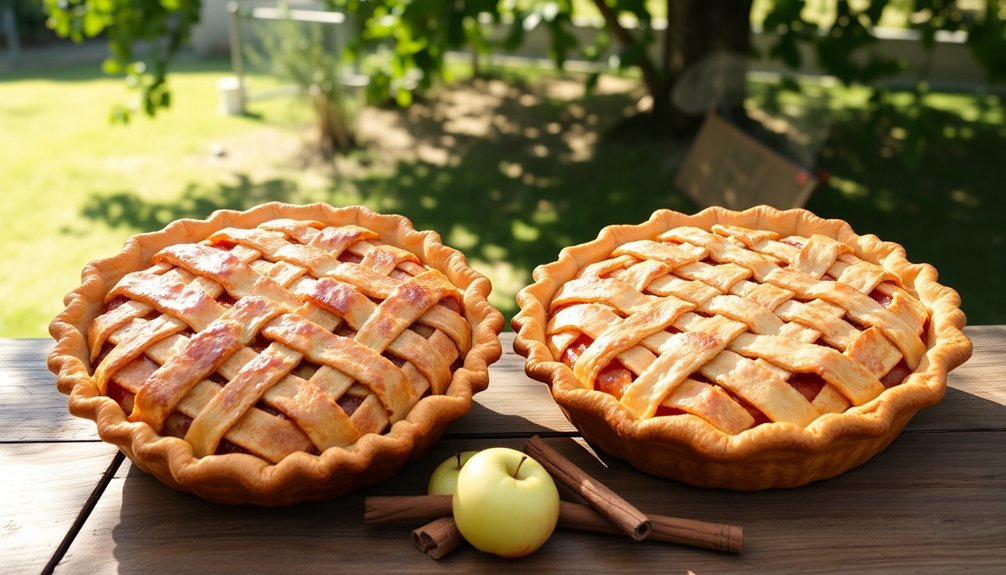



Leave a Reply